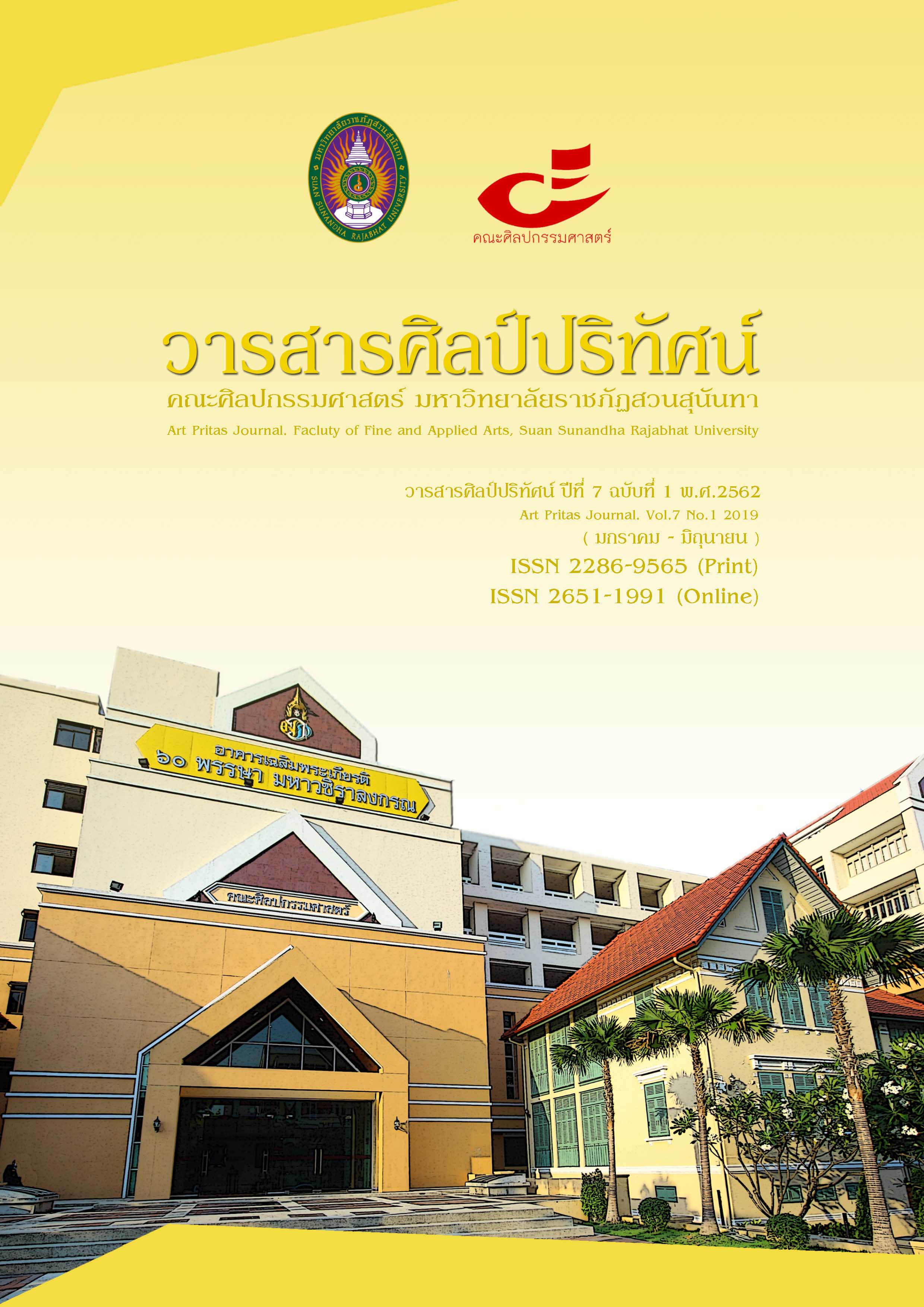การศึกษาการจัดการเรียนการสอน วิชาปฏิบัติเครื่องสายสากล กรณีศึกษานักเรียนโครงการพิเศษ โรงเรียนสารสาสน์วิเทศบางบอน
Main Article Content
บทคัดย่อ
งานวิจัยเชิงคุณภาพนี้มีวัตถุประสงค์ดังนี้ 1) เพื่อศึกษาการจัดการเรียนการสอนในวิชาปฏิบัติเครื่องสายสากล สำหรับนักเรียนโครงการพิเศษ สายการเรียนอังกฤษ - ดนตรี และ 2) เพื่อศึกษาปัญหาและอุปสรรคในการจัดการเรียนการสอนวิชาปฏิบัติเครื่องสายสำหรับนักเรียนโครงการพิเศษ สายการเรียนอังกฤษ - ดนตรี โรงเรียนสารสาสน์วิเทศบางบอน ใน 5 ด้าน ประกอบด้วย 1) ด้านหลักสูตร 2) ด้านผู้สอนและผู้เรียน 3) ด้านกระบวนการจัดการเรียนการสอนและกิจกรรมเสริมหลักสูตร 4) ด้านสื่อ อุปกรณ์และสถานที่ 5) ด้านการวัดผลและประเมินผล โดยศึกษาข้อมูลจากเอกสาร การสัมภาษณ์แบบ กึ่งโครงสร้างและการสังเกตแบบมีส่วนร่วม จากผู้อำนวยการโรงเรียน 1 คน ผู้บริหาร 3 คน ครูผู้สอน 4 คน และนักเรียนชั้นมัธยมศึกษาปีที่ 4-6 จำนวน 12 คน
ผลการวิจัยพบว่า 1) การจัดการเรียนการสอน ครูผู้สอนส่วนใหญ่จบการศึกษาในระดับปริญญาตรีทางด้านดนตรี มีประสบการณ์ในการสอน 7-14 ปี นักเรียนทั้งหมดไม่มีพื้นฐานทางดนตรีมาก่อน จัดการเรียนการสอนจัดแบบกลุ่มย่อยและแบบเดี่ยว โดยมุ่งเน้นการพัฒนานักเรียนเป็นรายบุคคล มีการจัดกิจกรรมเสริมหลักสูตรให้นักเรียนได้แสดงความสามารถทุกปี สื่อและอุปกรณ์ดนตรีโรงเรียนจัดหาให้นักเรียนครบถ้วนและมีคุณภาพดี มีห้องเรียนแยกตามเครื่องดนตรี มีการวัดผลในกระบวนการเรียนการสอนตลอดปีการศึกษา และใช้การประเมินแบบอิงเกณฑ์ 2) ปัญหาและอุปสรรคในการจัดการเรียนการสอนพบว่าครูกำหนดเนื้อหาการเรียนการสอนมีความยืดหยุ่นเกินไป นักเรียนจึงขาดความกระตือรือร้นในการเรียนและการฝึกซ้อม การจัดตารางเรียนพร้อมกันทำให้มีเวลาเรียนน้อย ปัจจุบันไม่มีการอบรมเชิงปฏิบัติการและการชมการแสดงคอนเสิร์ตซึ่งเป็นการสร้างแรงบันดาลใจให้นักเรียน ห้องเรียนมีเสียงดังรบกวน คับแคบ และไม่เพียงพอ การวัดผลมีครูผู้สอนให้คะแนนเพียงคนเดียวทำให้เกณฑ์การวัดอาจไม่เท่าเทียมกัน ทั้งนี้ในการสอบแต่ละครั้งครูผู้สอนมีการปรึกษาและขอคำแนะนำจากครูท่านอื่นๆ เพื่อให้การประเมินเป็นไปในทิศทางเดียวกันให้มากที่สุด
Article Details
เนื้อหาและข้อมูลในบทความที่ลงตีพิมพ์ในวารสารศิลป์ปริทัศน์ ถือเป็นข้อคิดเห็นและความรับผิดชอบของผู้เขียนบทความโดยตรง ซึ่งกองบรรณาธิการวารสารไม่จำเป็นต้องเห็นด้วย หรือร่วมรับผิดชอบใดๆ
บทความ ข้อมูล เนื้อหา รูปภาพ ฯลฯ ที่ได้รับการตีพิมพ์ในวารสารศิลป์ปริทัศน์ถือเป็นลิขสิทธิ์ของวารสารศิลป์ปริทัศน์
เอกสารอ้างอิง
ณรุทธ์ สุทธจิตต์. (2544). พฤติกรรมการสอนดนตรี : ฉบับปรับปรุงแก้ไข. (พิมพ์ครั้งที่3). กรุงเทพฯ : สำนักพิมพ์แห่งจุฬาลงกรณ์มหาวิทยาลัย.
ณรุทธ์ สุทธจิตต์. (2555). ดนตรีศึกษา หลักการและสาระสำคัญ. กรุงเทพฯ : จุฬาลงกรณ์มหาวิทยาลัย.
ดำริห์ บรรณวิทยกิจ. (2545). แนวการสอนดนตรีปฏิบัติอย่างมีประสิทธิภาพ สาระดนตรีศึกษา. กรุงเทพฯ : จุฬาลงกรณ์มหาวิทยาลัย.
ทิศนา แขมมณี. (2554). ศาสตร์การสอน : องค์ความรู้เพื่อการจัดกระบวนการเรียนรู้ที่มีประสิทธิภาพ. (พิมพ์ครั้งที่14). กรุงเทพฯ : จุฬาลงกรณ์มหาวิทยาลัย.
ประพันธ์ศักดิ์ พุ่มอินทร์. (2553). บทบาทของผู้ปกครองในการสนับสนุนการเรียนดนตรี. สืบค้น 16 มิถุนายน. จาก http://mcpswis.mcp.ac.th/html¬¬_edu/cgi bin/mcp/main_php/print_ informed.php?id_count_ inform=12059
ภานุวัฒน์ วัฒนจินดา. (2552). การพัฒนารูปแบบการสอนวิชาปฏิบัติเครื่องดนตรีกลุ่มเครื่องสายของโรงเรียนดุริยางค์ทหารอากาศ. ปริญญาครุศาสตรมหาบัณฑิต สาขาวิชาดนตรีศึกษา ภาควิชาศิลปะ ดนตรีและนาฏศิลป์ศึกษา คณะครุศาสตร์ จุฬาลงกรณ์มหาวิทยาลัย.
วิจิตรา เตรียมตระการผล. (2559, กรกฎาคม-ธันวาคม). การเรียนการสอนไวโอลินของแผนศิลป์ - ดนตรี ในโรงเรียนระดับมัธยมศึกษา เขตกรุงเทพมหานคร. วารสารศิลปกรรมศาสตร์ มหาวิทยาลัยขอนแก่น, 8(2), 185-204.
สุรางค์ โค้วตระกูล. (2554). จิตวิทยาการศึกษา. (พิมพ์ครั้งที่ 10). กรุงเทพฯ : จุฬาลงกรณ์ มหาวิทยาลัย.
อภิชัย เลี่ยมทอง. (2555, มกราคม-มิถุนายน). หลักสำคัญสำหรับการฝึกซ้อมดนตรีเพื่อประสิทธิภาพสูงสุด. วารสารดนตรีรังสิต, 7(1), 29-39.
อาภรณ์ ใจเที่ยง. (2550). หลักการสอน. (พิมพ์ครั้งที่4). กรุงเทพฯ : โอเดียนสโตร์.
Carroll, J.B. (1963). A model of school learning. Teacher College Record, 65, 723-733
Davies, I.K. (1971). The management of learning. London : McGraw Hill.
Steiner, E. (1988). Methodology of Theory Building. Sydney : Educology Research Associates.


